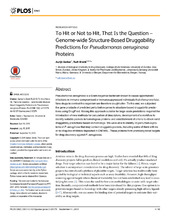| dc.contributor.author | Sarkar, Aurijit | en_US |
| dc.contributor.author | Brenk, Ruth | en_US |
| dc.date.accessioned | 2016-04-12T12:23:08Z | |
| dc.date.available | 2016-04-12T12:23:08Z | |
| dc.date.issued | 2015-09-11 | |
| dc.Published | PLoS ONE 2015, 19:e0137279(9) | eng |
| dc.identifier.issn | 1932-6203 | |
| dc.identifier.uri | https://hdl.handle.net/1956/11897 | |
| dc.description.abstract | Pseudomonas aeruginosa is a Gram-negative bacterium known to cause opportunistic infections in immune-compromised or immunosuppressed individuals that often prove fatal. New drugs to combat this organism are therefore sought after. To this end, we subjected the gene products of predicted perturbative genes to structure-based druggability predictions using DrugPred. Making this approach suitable for large-scale predictions required the introduction of new methods for calculation of descriptors, development of a workflow to identify suitable pockets in homologous proteins and establishment of criteria to obtain valid druggability predictions based on homologs. We were able to identify 29 perturbative proteins of P. aeruginosa that may contain druggable pockets, including some of them with no or no drug-like inhibitors deposited in ChEMBL. These proteins form promising novel targets for drug discovery against P. aeruginosa. | en_US |
| dc.language.iso | eng | eng |
| dc.publisher | Plos | eng |
| dc.rights | Attribution CC BY | eng |
| dc.rights.uri | http://creativecommons.org/licenses/by/4.0/ | eng |
| dc.title | To hit or not to hit, that is the question -genome-wide structure-based druggability predictions for pseudomonas aeruginosa proteins | en_US |
| dc.type | Peer reviewed | |
| dc.type | Journal article | |
| dc.date.updated | 2016-03-08T11:15:11Z | |
| dc.description.version | publishedVersion | en_US |
| dc.rights.holder | Copyright 2015 the authors | |
| dc.identifier.doi | https://doi.org/10.1371/journal.pone.0137279 | |
| dc.identifier.cristin | 1332480 | |

